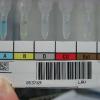
Ann in CA
Reputation Activity
-
 Ann in CA got a reaction from Walter Isenheim in Blood group discrepancy Ortho vision analyzer
Ann in CA got a reaction from Walter Isenheim in Blood group discrepancy Ortho vision analyzer
Hi Enamul,
This is a known "Limitation" of the Vision Analyzer stated in the Operator's Manual-I've added the statement below.
"When a sample is collected from a recently transfused patient, the potential exists for the transfused red cells to concentrate after centrifugation at the bottom of the sample tube below their autologous cells. The probe aspirates from the bottom of the tube where the transfused cells generally concentrate which may lead to an unexpected result."
We actually have this statement in our SOP as it can be very confusing!
~Ann in CA
-
 Ann in CA got a reaction from David Saikin in Inspection Questions
Ann in CA got a reaction from David Saikin in Inspection Questions
Also if you have implemented or updated your computer system, a new instrument/analyzer, or any other process be ready to show documentation regarding validation.
-
 Ann in CA reacted to Bb_in_the_rain in Mock-up cases
Ann in CA reacted to Bb_in_the_rain in Mock-up cases
For those of who works in transfusion service laboratory and would like to learn more reference cases, I can post some mock-up cases here. If you would like me to do it, please hit the "heart" button on this post. If enough folks want to practice case studies on reference lab cases, I can post mock-up cases here weekly or so..
-
 Ann in CA got a reaction from David Saikin in Blood group discrepancy Ortho vision analyzer
Ann in CA got a reaction from David Saikin in Blood group discrepancy Ortho vision analyzer
Hi Enamul,
This is a known "Limitation" of the Vision Analyzer stated in the Operator's Manual-I've added the statement below.
"When a sample is collected from a recently transfused patient, the potential exists for the transfused red cells to concentrate after centrifugation at the bottom of the sample tube below their autologous cells. The probe aspirates from the bottom of the tube where the transfused cells generally concentrate which may lead to an unexpected result."
We actually have this statement in our SOP as it can be very confusing!
~Ann in CA
-
 Ann in CA got a reaction from Enamul Haque in Blood group discrepancy Ortho vision analyzer
Ann in CA got a reaction from Enamul Haque in Blood group discrepancy Ortho vision analyzer
Hi Enamul,
This is a known "Limitation" of the Vision Analyzer stated in the Operator's Manual-I've added the statement below.
"When a sample is collected from a recently transfused patient, the potential exists for the transfused red cells to concentrate after centrifugation at the bottom of the sample tube below their autologous cells. The probe aspirates from the bottom of the tube where the transfused cells generally concentrate which may lead to an unexpected result."
We actually have this statement in our SOP as it can be very confusing!
~Ann in CA
-
 Ann in CA got a reaction from Malcolm Needs in Blood group discrepancy Ortho vision analyzer
Ann in CA got a reaction from Malcolm Needs in Blood group discrepancy Ortho vision analyzer
Hi Enamul,
This is a known "Limitation" of the Vision Analyzer stated in the Operator's Manual-I've added the statement below.
"When a sample is collected from a recently transfused patient, the potential exists for the transfused red cells to concentrate after centrifugation at the bottom of the sample tube below their autologous cells. The probe aspirates from the bottom of the tube where the transfused cells generally concentrate which may lead to an unexpected result."
We actually have this statement in our SOP as it can be very confusing!
~Ann in CA
-
 Ann in CA got a reaction from MOBB in Computer Crossmatches and Revised CAP regs
Ann in CA got a reaction from MOBB in Computer Crossmatches and Revised CAP regs
This "Note" to the CAP TRM.40670 requirement is lifted straight out of the FDA Computer Crossmatch Guidance of April 2011, page 6.
I don't know of any BECS smart enough to block the computer crossmatch for these cases of ABO typing discrepancies, so we will have to rely on a policy statement in our procedure(s).
I agree that this does not add value to patient safety, but rather confuses the poor bench tech with another If...then...policy statement in the procedure. Thanks MOBB for posting!
-
 Ann in CA got a reaction from gagpinks in Vision Data back up - archive
Ann in CA got a reaction from gagpinks in Vision Data back up - archive
We are configured to save "Database and Column Images". This will enable us to restore instrument configuration settings and images, as well as test/qc results. The test results are in our LIS, but the images are not. QC reports will be either saved electronically on a network drive or printed (multiple sites implemented-their choice). We also document QC pass/fail on a daily log. We have enabled the Active automatic images synchronization, as this downloads images continuously to the backup folder/device, making the monthly backup time to process a bit shorter.
-
 Ann in CA reacted to heathervaught in Bacterial Testing - Apheresis Platelets
Ann in CA reacted to heathervaught in Bacterial Testing - Apheresis Platelets
https://www.fda.gov/downloads/BiologicsBloodVaccines/GuidanceComplianceRegulatoryInformation/Guidances/Blood/UCM425952.pdf
This is in Draft status, but should be finalized this year. Once finalized, FDA will give 2 years for implementation. Transfusion services should not be mandated to make changes until some time in 2019 or later. There are some misstatements in some previous posts that should be clarified.
PAS apheresis platelets can be stored up to 5 days and must have a "safety measure" test within 24 hours of transfusion if transfused on Day 4 or 5. The use of platelet additive solution does not confer any protection against bacterial proliferation. Plasma-stored apheresis platelets can be stored up to 7 days and must have a "safety measure" test within 24 hours of transfusion if transfused on Day 4, 5, 6, or 7. Pathogen reduced apheresis platelets can be stored up to 5 days and can be transfused up until expiration without additional testing.
-
 Ann in CA got a reaction from AMcCord in childbearing age
Ann in CA got a reaction from AMcCord in childbearing age
We never had one, then decided to make it 55 years-we blame it on Janet Jackson...
-
 Ann in CA got a reaction from Likewine99 in Blood Bank LIS Replacement Advice Needed
Ann in CA got a reaction from Likewine99 in Blood Bank LIS Replacement Advice Needed
Hello,
I think you posted the same question on the AABB Hub, in which I cannot figure out on how to reply!
I have used both Haemonetics and Cerner products. I love Haemonetics, as it is very configurable to your needs.
I would assess your patient population (oncology, pediatrics, SCD, general) and what your current problems are. How could the new system help? What would it miss? My Cerner team tells me that there is no way to configure patients to receive type O RBC products only (neonate, HPC transplants). Haemonetics has no problem in setting up such a rule.
Once you determine your patient population, ask the vendor for a similar user site and do a site visit. Talk to the bench techs and ask them, where does the system fail?
The vendor will tell you that it's all good, but the user's will tell you where the holes are in the system.
Ultimately, it may be your purchasing team who makes the final decision. Once it's made, it's your job to fully understand the system and BUID IT RIGHT. Once it's built, it is hard to unbuild...
Hope this helps somewhat, I found systems administration very interesting, and even taught myself how to query the database and write Crystal reports. Hopefully you'll have the resources to make the best decision and going forward and design the system for your unique patient population and their needs.
Ann in CA
-
 Ann in CA got a reaction from Dansket in Blood Bank LIS Replacement Advice Needed
Ann in CA got a reaction from Dansket in Blood Bank LIS Replacement Advice Needed
Hello,
I think you posted the same question on the AABB Hub, in which I cannot figure out on how to reply!
I have used both Haemonetics and Cerner products. I love Haemonetics, as it is very configurable to your needs.
I would assess your patient population (oncology, pediatrics, SCD, general) and what your current problems are. How could the new system help? What would it miss? My Cerner team tells me that there is no way to configure patients to receive type O RBC products only (neonate, HPC transplants). Haemonetics has no problem in setting up such a rule.
Once you determine your patient population, ask the vendor for a similar user site and do a site visit. Talk to the bench techs and ask them, where does the system fail?
The vendor will tell you that it's all good, but the user's will tell you where the holes are in the system.
Ultimately, it may be your purchasing team who makes the final decision. Once it's made, it's your job to fully understand the system and BUID IT RIGHT. Once it's built, it is hard to unbuild...
Hope this helps somewhat, I found systems administration very interesting, and even taught myself how to query the database and write Crystal reports. Hopefully you'll have the resources to make the best decision and going forward and design the system for your unique patient population and their needs.
Ann in CA



